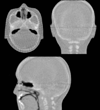Development of proton computed tomography detectors for applications in hadron therapy
- PMID: 26957679
- PMCID: PMC4779442
- DOI: 10.1016/j.nima.2015.07.066
Development of proton computed tomography detectors for applications in hadron therapy
Abstract
Radiation therapy with protons and heavier ions is an attractive form of cancer treatment that could enhance local control and survival of cancers that are currently difficult to cure and lead to less side effects due to sparing of normal tissues. However, particle therapy faces a significant technical challenge because one cannot accurately predict the particle range in the patient using data provided by existing imaging technologies. Proton computed tomography (pCT) is an emerging imaging modality capable of improving the accuracy of range prediction. In this paper, we describe the successive pCT scanners designed and built by our group with the goal to support particle therapy treatment planning and image guidance by reconstructing an accurate 3D map of the stopping power relative to water in patient tissues. The pCT scanners we have built to date consist of silicon telescopes, which track the proton before and after the object to be reconstructed, and an energy or range detector, which measures the residual energy and/or range of the protons used to evaluate the water equivalent path length (WEPL) of each proton in the object. An overview of a decade-long evolution of the conceptual design of pCT scanners and their calibration is given. Results of scanner performance tests are presented, which demonstrate that the latest pCT scanner approaches readiness for clinical applications in hadron therapy.
Keywords: WEPL; hadron therapy; head scanner; proton computed tomography; proton detector; range measurement.
Figures















References
Grants and funding
LinkOut - more resources
Full Text Sources
Other Literature Sources
